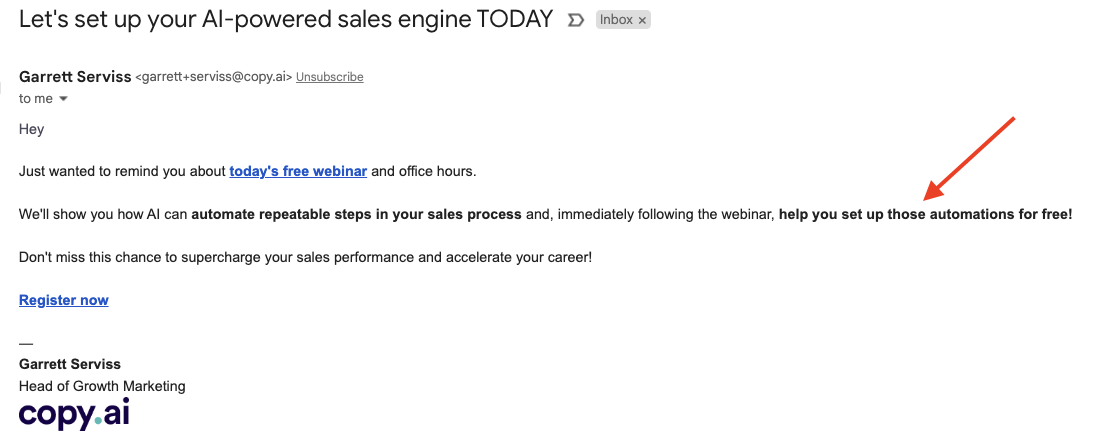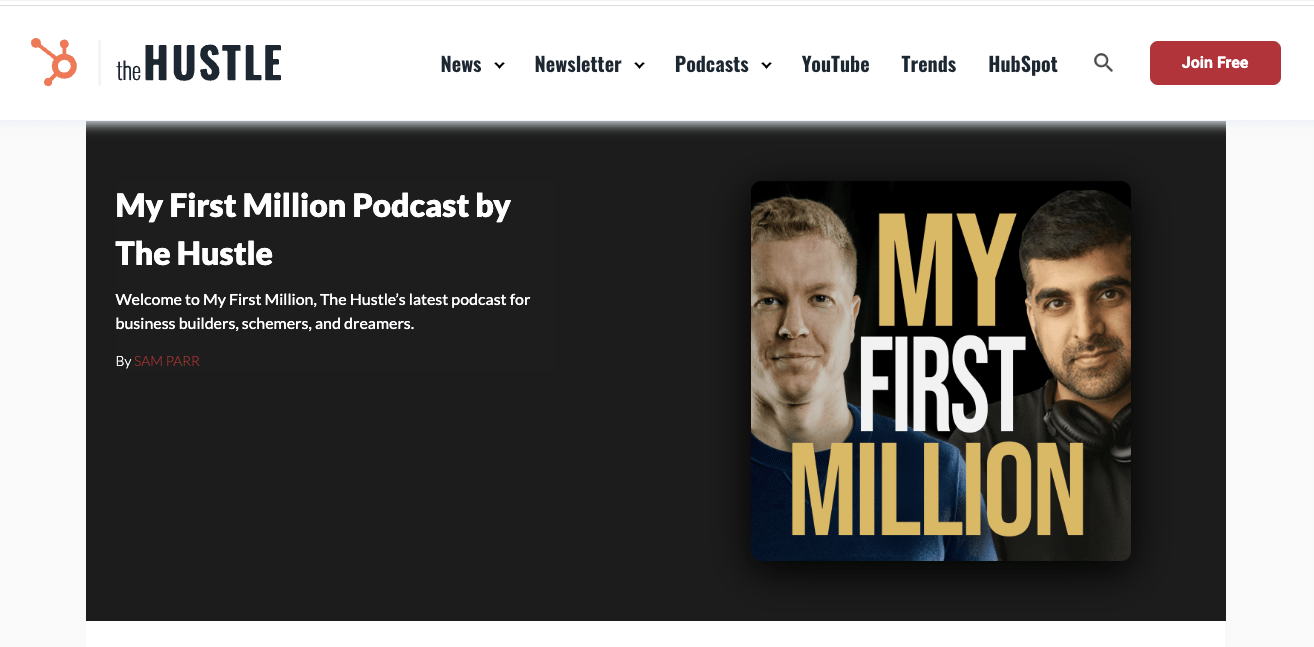What do Jasper, Stripe, and ClickUp have in common?
Besides being unicorn SaaS companies, they all understand the importance of building a loyal customer base to achieve success. Satisfied customers who couldn’t help but spread the word about their exceptional products paved the path to their meteoric growth.
Why not follow the lead by shifting your focus away from paid channels and toward SaaS relationship marketing?
With the right combination of SaaS relationship marketing strategies in your arsenal, you can create lasting relationships with your customers, increase customer loyalty, and drive revenue growth for your business.
So are you ready to build strong, lasting relationships with your customers?
Let’s dive in.
Don’t wait for the muse. Apply this step-by-step method to write high-performing email campaigns in hours, not weeks.
What is SaaS relationship marketing?
SaaS relationship marketing is an approach that includes putting your customers first and nurturing lasting connections with them. It’s a customer-centric approach that aims to win new clients and keep them happy and loyal for the long haul.
So what’s the magical formula for success? It’s all about ongoing engagement, education, and support.
By providing personalized experiences and addressing your customers’ needs at every stage of the buyer’s journey, you’ll win their trust, encourage them to stick around, and even become advocates for your brand.
Now let’s discuss why customer retention is crucial in the SaaS world. Here are some key benefits that make it worth your while to invest in building strong relationships with your customers.
Maximize customer lifetime value
When you retain customers longer, they’re more likely to continue using your product and even upgrade to higher-priced plans.
Why? They already trust you and understand the value that you bring to the table.
In other words, you’re unlocking a higher customer lifetime value, which translates to more revenue for your business (read: more money in your pocket).
Reduce churn
Churn, the rate at which customers cancel their subscriptions, can significantly drain your resources and morale.
Doubling down on customer satisfaction and nurturing relationships helps minimize churn and keeps those clients you worked so hard to convert.
Increase customer satisfaction
Happy customers are more likely to stick around and even recommend your services to others.
By prioritizing their needs and constantly improving your offerings (to meet those needs), you’ll create a loyal fan base that’s happy to keep using your software.
Drive customer advocacy
When customers feel valued and appreciated, they’re more likely to sing your praises to friends, family, and colleagues.
This word-of-mouth marketing is incredibly powerful, as people trust personal recommendations over traditional advertising. According to HubSpot, 64% of people install ad blockers because ads are annoying and intrusive — we don’t blame them.
So, are you ready to unlock the true potential of SaaS relationship marketing to build a thriving and sustainable business?
Happy customers are the backbone of any successful enterprise — and your SaaS company is no exception. Let’s get started on creating those lasting connections.
Strategy 1: Double down on customer onboarding
We’ve already discussed the importance of SaaS relationship marketing and its role in customer retention. Now, let’s dive into one of the key aspects that can make or break those relationships: customer onboarding.
Customer onboarding introduces new clients to your SaaS product, helping them understand how it works and providing the necessary tools and support to ensure their success.
It’s a vital step in the customer journey, as it sets the stage for a positive experience and builds a strong foundation for ongoing engagement.
Why is customer onboarding so crucial to customer retention? Here’s why:
- Sets the tone for a positive customer experience: A smooth and efficient onboarding process helps create a great first impression, which can lead to long-lasting customer satisfaction.
- Reduces frustration and increases engagement: When customers understand how to use your SaaS product from the get-go, they’re less likely to experience frustration and more likely to engage with it.
- Reduces early-stage churn: A well-executed onboarding process can minimize the risk of customers canceling their subscriptions after a free trial ends.
- Builds stronger connections: Personalized onboarding experiences can help customers feel valued and appreciated, fostering a deeper connection with your brand.
And we’re only scratching the surface. So let’s dive into a few quick best practices for delivering the best possible onboarding experience:
- Build a library of educational content, including videos and articles, to help customers get started on the right foot.
- Remember, not all SaaS products are meant to be entirely self-serve — sometimes, the human touch is necessary. Add one-on-one onboarding meetings to the mix.
- Hire a customer success team to build relationships with clients and guide them through their journey.
- Focus on service design, not just product design, to ensure a seamless customer experience.
If there’s one common theme here, it’s this: personalization. So tap into your customer data platform to help you compile detailed profiles of your customers to improve your personalization efforts during onboarding.
What works for one customer might not work well for the next. Adapt your onboarding processes accordingly to improve the customer experience and boost your bottom line.
Remember, first impressions matter. So it’s all about nurturing connections from the beginning and continuously providing unique value to your customers. That’s the secret sauce to SaaS relationship marketing.
Strategy 2: Offer proactive customer support
Did you know that 61% of consumers will stop buying from you and switch to a competitor after just one poor customer service experience?
Sadly, this isn’t baseball where you get three strikes before you’re out. That’s why providing stellar client support is essential in SaaS relationship marketing. And being proactive in your approach can make all the difference.
So what’s proactive customer support? It’s all about anticipating your customer’s needs and addressing potential issues before they even arise.
How is that even possible? You can’t predict the future. But with the power of marketing analytics, you can analyze prior trends to help guide you in the right direction.
For instance, you might uncover that during periods of economic uncertainty, your customers tend to tighten the reins on their expenses.
During these times (we’re looking at you, 2023), it’s worth offering discounts for annual renewals or other discount codes to encourage upfront purchases before you see a mass exodus when budgets get tight. Plus, your customers will appreciate the gesture.
If you prefer the relationship approach, you can actively reach out to clients to prevent small concerns from snowballing into larger problems. The result? Happier customers and increased loyalty.
Here are some ways to leverage this approach:
- Send regular emails or in-app messages to check customers’ progress and offer assistance if needed.
- Make a personal connection with your most important (high-value) clients through periodic phone calls or video meetings.
- Set up quarterly business reviews and other strategic meetings to discuss performance, goals, and improvement areas with your customers.
Let’s look at an example of proactive customer support in action.
Copy.ai, a SaaS company specializing in AI-driven workflows, sends an email sharing their upcoming office hours to help existing customers set up an AI-powered sales workflow to optimize the sales process and reduce mundane tasks.

This proactive approach by Copy.ai ensures that the customer is getting the most out of their SaaS product and makes them feel valued and supported. Plus, the customer doesn’t have to search for ways to connect with the SaaS tool, reducing friction and saving time.
Here’s the scoop on the benefits of proactive customer support:
- It prevents issues from escalating
- You can create a competitive advantage
- Customers take notice and feel cared for
By offering proactive customer support, you’re preventing problems and building trust by nurturing relationships that can stand the test of time.
And remember: your customers’ success is yours. Go the extra mile and show them you truly care. It’ll pay off tenfold.
Strategy 3: Implement a loyalty program
Loyalty programs have been around for ages across various industries. While they’re not as common in the SaaS world, they can help you stand out from the thousands of other SaaS products on the market.
Customer loyalty programs are structured marketing strategies designed to incentivize customers to continue using your product or service, rewarding them for their ongoing support and engagement.
These programs can take various forms, such as point systems, tiered rewards, or exclusive benefits for certain user groups.
Take RingCentral, for example. Developers can earn points to redeem awesome prizes and connect with leading experts. It’s an easy way to keep users engaged with your product. And who doesn’t like free stuff?

Don’t underestimate the power of a loyalty program. They’re uncommon for SaaS products, but they’re valuable. Creating a loyalty program is your fast-track ticket to standing out in the competitive SaaS landscape. Why not give it a try?
Strategy 4: Leverage communities
Communities play a significant role in fostering strong connections between your customers and your brand. After all, we’re social beings, and there’s nothing better than finding and being a part of a group of like-minded people.
By leveraging the power of communities, you can create an environment where customers engage with your product and connect with one another, exchanging ideas, knowledge, and experiences.
Here’s how you can leverage communities to strengthen customer relationships and drive retention:
- Organize regular social events like Userlist’s Happy Hours
- Run conferences and online events
- Hang out in existing professional communities
- Maintain your own community using platforms like Slack or Circle
HubSpot, a leading inbound marketing platform, started HubSpot User Groups (HUGs) as part of its SaaS relationship marketing strategy.

HUGs are local, in-person meetups where users can network, learn from each other, and share best practices for using the platform. Through exclusive access to these events, HubSpot keeps its customers engaged and fosters community and loyalty among users. Well done, HubSpot.
Don’t wait for the muse. Apply this step-by-step method to write high-performing email campaigns in hours, not weeks.
Strategy 5: Create a referral program
Maybe you’re not interested in going against the grain with a loyalty program. Don’t worry. There’s another alternative. Enter referral programs.
Referral programs tap into the power of word-of-mouth marketing by encouraging your existing customers to spread the word about your SaaS platform to their friends, family, and colleagues.
Let’s dive into the mechanics of referral programs and how they can benefit your SaaS relationship marketing strategy.
Referral programs typically provide customers with a unique referral link or code they can share with others. When someone signs up for your SaaS platform using this link or code, the referrer, and the new customer receive a reward. A true win-win.
You can structure rewards in various ways, such as discounts, account credits, or even free access to premium features. For example, here’s a look at Canva’s referral program, where the friend and the referrer unlock access to premium photos, icons, and illustrations.

So why do Canva and other popular SaaS products offer referral programs?
Well, the benefits of referral programs are numerous:
- Increase customer acquisition by tapping into your customers’ networks through trusted personal recommendations over traditional advertising.
- Improve customer retention as customers referring new users become more invested in your platform and are more likely to remain loyal users themselves.
- Reduce marketing costs by leveraging your existing customer base to attract new users.
Strategy 6: Keep educating your customers
SaaS relationship marketing is not a walk in the park. Despite this, there are always creative ways to help boost customer retention.
For instance, constantly updating your software provides the best possible user experience and protects customers from security vulnerabilities.
And at the same time, maintaining an active SaaS blog where you talk about the merits of your software, how to use new features, and many other important topics to educate your customers can work wonders to keep customers engaged.
Why? An ongoing learning experience helps them get the most out of your platform and reinforces their trust in your brand.
So how do you keep the education flowing after the onboarding phase?
- Regularly publish articles on your blog that cover various topics related to your product, industry trends, and best practices.
- Curate and send newsletters sharing educational content, product updates, and other relevant information.
- Feature educational content in evergreen campaigns, such as guides or video tutorials
- Share high-quality, relevant content from other sources to improve your customers’ learning experience and showcase your commitment to their success.
ClickUp successfully educates its customers by encouraging them to sign up for the ClickUp Blog Newsletter. That way, they get fresh, hot tips from industry experts delivered to their inboxes. No muss, no fuss.

An educated customer is an empowered customer. Sharing valuable educational resources can help your customers unlock the full potential of your SaaS platform.
So keep the knowledge flowing, and watch your customers thrive.
Strategy 7: Focus on your mission
As Simon Sinek points out in his book, Start With Why, the most successful brands focus on a bigger story that transcends the immediate use of their products.
So, take a moment and evaluate your mission — is it at the forefront of your SaaS relationship marketing strategy? If not, it’s time to refocus and share the bigger story that sets your brand apart.
From email campaigns to social media posts, consistently highlight your mission and values across all customer touchpoints. This messaging helps reinforce your brand story and reminds customers of the “why” behind your product.
Demonstrate your commitment to your mission by delivering on your promises and upholding your core values in every aspect of your business. It’s a surefire way to build credibility and trust with your customers, as we all know that actions speak louder than words.
Take Mos as a shining example. With a mission to tear down financial barriers to opportunity and help students find more money to further their education, they go out of their way to provide free educational content to help students with the college application process.

From free webinars about how to lower college tuition costs to in-depth guides on grants, Mos doesn’t leave any stone unturned. They’re dedicated to achieving their brand’s mission, and these actions prove it.

Plus, a strong mission can inspire loyalty and foster a sense of belonging. Your customers will appreciate it, and your business will thrive.
Strategy 8: Build trust in your brand
Trust is the foundation of any strong personal relationship. The same holds true for your relationship with your customers.
While we’ve touched on various ways to build customer trust, you can take it up a notch by sending fewer emails (quality over quantity) or doubling down on exceptional evergreen content.
But wait, there’s more. Clear communication around pricing, fees, and any changes affecting your customers helps establish trust and sets the stage for a positive customer experience.
A dedicated pricing page on your website can remove confusion and demonstrates your focus on transparency —as MarketMuse does with this simple, clean pricing table for its AI content planning platform.

This openness not only fosters trust among potential customers but also streamlines the purchasing process, reducing bounce rates and boosting conversions.
Why? When you present your pricing details upfront instead of hiding them behind a sales call, your website visitors are more likely to proceed with the purchase.
And of course, offering free trials for each pricing tier is a fantastic way to let users give the platform a try before fully committing.
Strategy 9: Entertain your customers
Let’s face it. We’re all busy people trying to balance work, life, and having some fun. So why not tap into the power of entertainment to build stronger relationships with your customers?
Creating enjoyable experiences can turn something that feels like a chore into something your customers look forward to. Here are some ways to entertain and delight your customers:
- Host webinars or virtual events
- Develop interactive quizzes or games
- Create online forums or discussion boards
- Launch a branded podcast
HubSpot does an excellent job of entertaining existing customers and attracting new customers through its My First Million Podcast. Co-hosts Sam Parr and Shaan Puri brainstorm new business ideas based on trends and opportunities they see in the market, with some added humor.

Humor can be a powerful tool to entertain and connect with your customers, but it’s important to strike the right balance. Aim to be genuinely funny without forcing the “fun” aspect — let it come naturally. And make sure you’re having fun along the way!
With that, let your creative juices flow and start entertaining your customers — they’ll appreciate the effort, and your brand will stand out in their minds.
Strategy 10: Use continuous improvement
And finally, you should always seek ways to improve your processes, products, and services over time.
Why? Continuous improvement is the recipe for success to stay ahead of your competition and implement new features and improvements that’ll meet or exceed the evolving needs of your customers.
To make continuous improvement a part of your SaaS relationship marketing strategy, solicit regular customer feedback through surveys, polls, or social listening tools.
When you actively listen to your customers and demonstrate that their opinions matter, you’re genuinely committed to providing the best possible SaaS solution for their needs — rather than only being in it for the money.
Ready to start your SaaS relationship marketing journey?
The most successful SaaS companies have built their success on a foundation of loyal customers who champion their products.
By implementing one or a combination of these SaaS relationship marketing strategies, you can create lasting relationships with your customers and keep them coming back for more.
Whether doubling down on the onboarding process, being proactive with your customer support, or investing in loyalty and referral programs, these strategies will help you build trust with your customers and improve their overall experience with your brand.
Remember, focusing on customer retention is more cost-effective than solely acquiring new customers and a proven way to build a loyal customer base. And that’s the recipe for success in the highly competitive world of SaaS.
Are you ready to take your SaaS marketing to the next level? Start your own SaaS relationship marketing journey today, and you, too, can be on the fast track to unicorn status.
Don’t miss out on new articles. Subscribe to our newsletter and get your monthly dose of SaaS email marketing insights.





